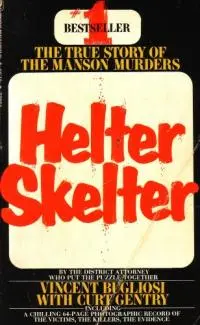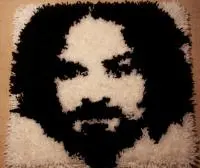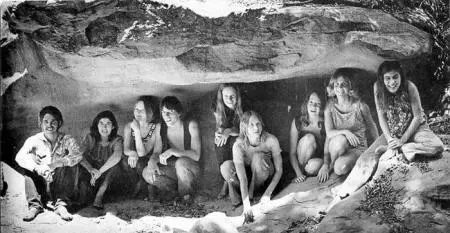In the near corner - Helter Skelter, by Vincent Bugliosi (with Curt Gentry). In the far corner – The Family, by Ed Sanders. Yes, sports fans, it’s a family feud – the Manson Family.
Let me tout my credentials as referee. The background, crimes, and aftermath of Charles Manson, who was responsible for the gruesome murder of Roman Polanski’s pregnant wife, Sharon Tate, and others, is one of my most enduring guilty pleasures. (Unlike most of my so-called guilty pleasures, I really do feel guilty about finding pleasure in this one.) I was both creeped-out and riveted from the get-go.
I was 12 at the time. The first round of killings occurred during the early hours of August 9, 1969 at the house Polanski and Tate had rented high in the hills of Bel Air. The housekeeper, Winifred Chapman, discovered the bodies when she showed up for work in the morning. By that evening, the horrific story dominated the news, and I’ve been a Manson junkie ever since. The following night’s grotesquery at the home of Leno and Rosemary LaBianca, complete with a fork stuck in Leno’s stomach and a word misspelled in blood on the refrigerator, only served to heighten my taste for Manson-related gore.
I’ve read both The Family and Helter Skelter more times than I can count. In the late 1980s, when I was in Los Angeles doing photo research for my first book (Screwball), I took off for Benedict Canyon one afternoon and parked in front of 10050 Cielo Drive, where the Tate murders took place. There wasn’t much to see; the house isn’t visible from the street, but I was pulled there as if by a magnet. I own most of the literature, including Witness to Evil by George Bishop and the even rarer and more pathetic Child of Satan, Child of God by one of the killers, the I’ll-say-anything-to-get-out-of-prison Susan Atkins. In 1990, I got to stage-manage Ridge Theater’s production of John Moran’s avant-garde opera The Manson Family at Lincoln Center’s Avery Fisher Hall. I have even discussed the murders with Roman Polanski himself.
And now...Ding! Let the brawl begin!
Round One: Judging a Book by Its Cover


That dumb cliché has it entirely backwards: we’re supposed to judge books by their covers. That’s the entire point of cover designs – to attract readers (or more accurately buyers) to books by way of their initial visual appeal. The Family’s first-edition cover is undistinguished. Its design is based on the book’s subtitle, The Story of Charles Manson’s Dune Buggy Attack Battalion: a red dune buggy reproduced all over the jacket, receding in perspective against a deep blue background. While it’s true that Manson had a thing for dune buggies, and that he believed that his dune buggies would transport the family deep into the desert once the worldwide race war started (I’ll get to that subject later, I promise you; the idea is so berserk that it deserves much examination) the dune buggy is one of the least intriguing aspects of the case. It’s a pointless subtitle and an equally meaningless cover design.
Helter Skelter, on the other hand, features the eponymous words in blood red against a white rectangle, with the S and R of the second word bleeding off the white and onto plain black, a clever visual pun. The cover is a reasonably tasteful way of reminding the potential reader that the LaBiancas’ killers wrote the words “Helter Skelter” on the wall in blood. In fact, the scribe, Patricia “Katie” Krenwinkel, was evidently not the brightest bulb in the chandelier; she misspelled “Helter” as “Healter.” This is a good object lesson: whenever you attempt to enhance the drama of two violent homicides by writing something in the victims’ blood, get the spelling right.
The first round goes to Helter Skelter.
Round Two: Explaining Insanity
The Tate and LaBianca murders appeared at first to be entirely random. There was a shitload of drugs involved - Tate's friends had some, and the Family thrived on them - along with the homicidal maniacs, the movie star, the coffee heiress (Abigail Folger), and the hairdressing magnate (Jay Sebring). Making sense out of the Family’s murderous nonsense requires one to use ratiocination on the one hand and paradoxically to suspend belief in rationality on the other. This is a true-crime detective story with a motive so wacked out that one needs to be carefully nurtured into believing it.
 Charles Manson, an itty-bitty crackpot (he's surprisingly short, and probably even shorter now that he’s within spitting distance of 80) who nevertheless held great persuasive powers, convinced his “Family,” the collection of drifters and grifters and needy women he’d accumulated since his days in San Francisco’s Haight-Ashbury district in 1967, that the Beatles were sending him coded messages through the vehicle of the White Album, messages that predicted an inevitable race war, which would begin with a spate of murders of white people which the public would naturally assume to have been committed by crazy black people, though they’d actually be the work of the Family, and then the white people would start killing the black people for vengeance, but then the black people would get mad and would kill off most of the white people, but then the blacks would realize that they didn’t have the intelligence to exercise their newfound power so they’d make Charles Manson ruler of the world. Oh, and the Family would survive the anti-white-people genocide because they’d be hiding out in a utopian underground chamber deep beneath Death Valley.
Charles Manson, an itty-bitty crackpot (he's surprisingly short, and probably even shorter now that he’s within spitting distance of 80) who nevertheless held great persuasive powers, convinced his “Family,” the collection of drifters and grifters and needy women he’d accumulated since his days in San Francisco’s Haight-Ashbury district in 1967, that the Beatles were sending him coded messages through the vehicle of the White Album, messages that predicted an inevitable race war, which would begin with a spate of murders of white people which the public would naturally assume to have been committed by crazy black people, though they’d actually be the work of the Family, and then the white people would start killing the black people for vengeance, but then the black people would get mad and would kill off most of the white people, but then the blacks would realize that they didn’t have the intelligence to exercise their newfound power so they’d make Charles Manson ruler of the world. Oh, and the Family would survive the anti-white-people genocide because they’d be hiding out in a utopian underground chamber deep beneath Death Valley.
So.
Exploring this extraordinarily warped motive requires two knacks – intense lucidity and the ability to imagine insanity. Bugliosi, who was the lead prosecutor on the case, is nothing if not logical. Much of Helter Skelter concerns the trial of Manson and his three psychokiller women – Krenwinkel, Atkins, and Leslie Van Houten. It reads as a legal procedural – nothing but the facts, ma’am. Sanders, who had no other connection to the murders and the ensuing legal case, takes a much freer and more creative approach. As a result, his rendition of Family life is more fun. It takes an expanded brain to get around the concepts Family members took for granted – Charlie’s true identity as Jesus, for instance. Bugliosi scores on logic; Sanders scores on free-flying imagination.
Round Two: a TIE.
Round Three: It’s All About Me
Bugliosi openly builds his book around himself; he’s the protagonist whose quest is to bring the bloodstained nuts to justice. This has both positive and negative consequences. Yes, it makes sense to pit the American judicial system against the dark chaos represented by Charlie, but it’s also more than slightly self-serving. Bugliosi constantly mentions police errors and misfires, details that oh-by-the-way remind us that Bugliosi is Our Hero – that without him, Manson and his crazy chicks would be roaming the streets to this day. That’s a bit much.
Sanders is a lot less concerned with his own role in the story. Of course that’s easier for him, since in fact he neither played a role in the investigation nor the trial. But he could have amplified his part in his story – the legwork reporting he did into the Manson Family’s activities before the murders for which they became notorious. He periodically employs the first person when describing what he learned through the countless interviews he conducted with Manson hangers-on and witnesses to crimes apart from the Tate-LaBianca murders, but he never places himself in the starring role. Bugliosi comes off as a braggart. Sanders is less full of himself.
Round Three goes to The Family.
Round Four: Satan Is in the Details
“I’m the Devil! And I’ve come to do the Devil’s work!” This is what “Tex” Watson, one of the relatively few male Manson groupies, told Voytek Frykowski before he, Atkins and Krenwinkel killed him and his friends – Tate, Folger, and Sebring – along with Steve Parent, a teenager who happened to be in the worst possible place at the worst possible time: he was driving down the driveway on his way home when the Manson gang arrived.
In one sense, all murderers are the same. They all killed people. But the Manson Family went out of its way to be colorful. And both Helter Skelter and The Family are full of lurid details. We learn in both that:
- Leslie Van Houten said that the more she stabbed, the better it felt.
- Katie Krenwinkel was so hairy that the Family’s guys, who weren’t especially choosy, never wanted to fuck her.
- Lynette “Squeaky” Fromme was one of the original Family members; one of her jobs for Manson was to screw the 80-year-old owner of the Spahn Movie Ranch, where the Family hung out. After the publication of both books, Squeaky achieved fame on her own as Gerald Ford’s would-be assassin.
- One of the Manson boys, Danny DeCarlo, earned the nickname “Donkey Dan” because of his immense dick. And on and on.
The Family at Spahn Ranch, courtesy steelbanans.com
But of the two books, The Family is by far the most colorfully detailed. Unlike the proper Bugliosi and his oh-so-responsible valorization of facts, Sanders is willing to bring up an enormous number of unproven theories, unverified occurrences, intriguing coincidences, and otherwise imaginative speculations.
He asserts, for example, that the full story of the Manson Family has never been told, intimating a connection between the Tate house and the LaBianca house that’s never been securely made. He mentions all sorts of people on the periphery. For instance, he briefly introduces Charlene Cafritz, who got a $2 million divorce settlement and spent it all in less than a year, much of it on Manson. He then drops the following bombshell: “Mrs. Cafritz took numerous motion pictures of Manson and the Family in Reno which no one wants to discuss. Mrs. Cafritz was a friend of Sharon Tate and Terry Melcher (Doris Day’s son) and many others associated with the oncoming tragedy.” Although Bugliosi ends his book with a series of unanswered questions, Sanders riddles his book with them, making for a less scripted, more true-to-life saga.
Round Four goes to The Family.
Round Five: The Golden Nugget
The Manson Family certainly produced enough weirdness to last several lifetimes, and both Helter Skelter and The Family contain many pithy paragraphs that blow the mind. But both books feature what might be called Golden Nuggets – groups of sentences that leave the reader speechless. There are many, many to choose from in both books.
Here’s my favorite nugget from Helter Skelter: Susan Atkins is telling her cellmate Virginia Graham about Charlie’s plan to murder Elizabeth Taylor and Richard Burton. She’s already described how they were going to scar Taylor’s face and gouge out her eyes. “Then, Susan continued, she would castrate Burton, placing his penis as well as Elizabeth Taylor’s eyes, in a bottle. ‘And dig this, would you!’ Susan laughed. “And then I’d mail it to Eddie Fisher!”
I also like this casual detail from The Family, in the chapter devoted to a police raid at the Spahn Movie Ranch, where the Family was living: “Everybody was arrested and placed in the circle. Two helicopters whirred overhead, creasing the hair below when dipping near. One of the dogs was running around wearing a brassiere placed on it by someone in the family.”
Round Five goes to Helter Skelter.
Round Six: The Smug Factor
There are Manson junkies, and there are Manson junkies. The nation was held in thrall during the investigation and lengthy trial of Manson, Atkins, Krenwinkel, and Van Houten, but time has dulled the murders' allure. Still, appearing in public carrying a copy of Helter Skelter elicits random remarks from strangers. "Great book," they say. "I was scared shitless."
Ho hum.
Helter Skelter was a bestseller, so it's not surprising that lots of readers remember it vividly. The Family is more of an insider's guide to Charlie and his profoundly fucked-up followers. So when a stranger sees you reading Helter Skelter on the subway or in a park, you can smugly say, "The Family is much better." You don't even have to read it to make the claim.
Round Six and the match go to The Family.
Got a favorite Manson Family member? Obsessed with another hideous crime? Appalled that I'm getting off on human tragedy? Lemme know your thoughts.

About the author
Ed Sikov is the author of 7 books about films and filmmakers, including On Sunset Boulevard:; The Life and Times of Billy Wilder; Mr. Strangelove: A Biography of Peter Sellers; and Dark Victory: The Life of Bette Davis.








